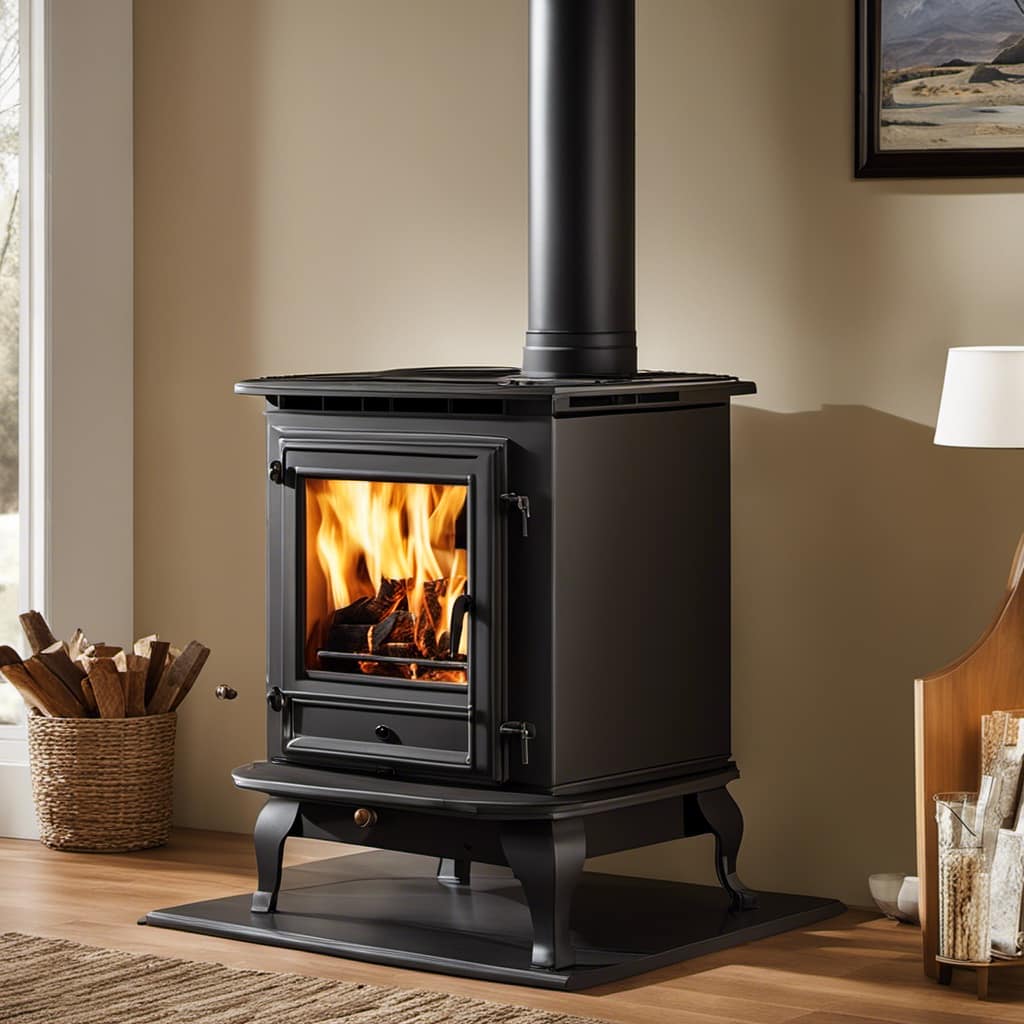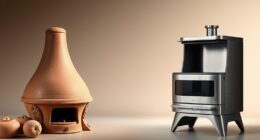As someone who enjoys taking on DIY projects, I understand the frustration that comes with dealing with a malfunctioning electric wood stove fan. But there’s no need to worry! This article will help walk you through the steps to fix your fan, one at a time.
From identifying common causes of failure to testing and repairing the motor and switch, we’ll cover it all.
So grab your tools and let’s get those fans spinning again in no time.
Key Takeaways
- Regular maintenance, including cleaning the fan blades and motor, is essential to prevent dust buildup and overheating.
- Checking and replacing the fan motor when necessary is crucial for maintaining functionality and preventing motor burnout.
- Testing the fan switch for continuity and repairing any loose or damaged wiring connections is important for proper fan operation.
- Cleaning the fan blades and housing, lubricating the fan motor, and checking electrical connections are all necessary steps for maintaining and fixing electric wood stove fans.
Understanding the Common Causes of Electric Wood Stove Fan Failure
I’ve been researching the common causes of electric wood stove fan failure, and it seems that dust buildup is often to blame. Dust can accumulate on the fan blades and motor, obstructing airflow and causing the fan to overheat. This can lead to the fan’s motor burning out, resulting in a complete failure of the fan system.

Regular maintenance is essential to prevent this from happening. By keeping the fan and its surrounding area clean and free from dust and debris, you can ensure proper airflow and prevent overheating.
Additionally, checking and replacing the fan motor when necessary is crucial for maintaining the functionality of the electric wood stove fan. Proper maintenance and timely replacement of faulty parts will help prolong the lifespan of your fan and ensure its efficient operation.
Checking and Replacing the Fan Motor
Regularly checking the fan motor and promptly replacing any faulty parts is essential for ensuring the efficient operation of the electric wood stove fan.
One important aspect of maintenance is replacing fan blades when necessary. Over time, fan blades can become worn or damaged, which can lead to reduced airflow and decreased performance. By regularly inspecting the fan blades, you can identify any signs of wear or damage and replace them as needed.

Additionally, lubricating the fan bearings is crucial for maintaining smooth and quiet operation. Over time, the bearings can become dry or worn, resulting in increased friction and noise. By lubricating the bearings at regular intervals, you can prevent these issues and extend the lifespan of the fan motor.
Testing and Repairing the Fan Switch
To ensure the proper functioning of the electric wood stove fan, it’s important to test and repair the fan switch as needed. The fan switch is responsible for controlling the on and off function of the fan, and if it isn’t working correctly, the fan may not turn on or off as desired.
To test the fan switch, you can use a multimeter to check for continuity. Simply disconnect the power supply, remove the switch from the circuit, and test the continuity between the terminals. If there’s no continuity, it indicates a faulty switch that needs to be replaced.
Common issues with fan switches include loose or damaged wiring connections, worn out contacts, or a malfunctioning switch mechanism. By testing and repairing the fan switch, you can ensure that your electric wood stove fan operates smoothly and efficiently.

Troubleshooting and Fixing Electrical Connections
I can troubleshoot and fix electrical connections to ensure the proper functioning of my electric wood stove fan.
When troubleshooting common issues, it’s important to first identify faulty components. Here are some steps to help you troubleshoot and fix electrical connections on your electric wood stove fan:
- Inspect the power cord for any visible damage such as cuts or frayed wires.
- Check the electrical outlet to ensure it’s functioning properly by plugging in another device.
- Use a multimeter to test the continuity of the wires and connections within the fan.
By following these steps, you can identify and fix any electrical connection issues that may be affecting the performance of your electric wood stove fan.
Once the electrical connections are fixed, you can move on to cleaning and maintaining your electric wood stove fan to ensure its longevity and efficiency.

Cleaning and Maintaining Your Electric Wood Stove Fans
After troubleshooting and fixing the electrical connections, I can now focus on regularly cleaning and maintaining my electric wood stove fan to ensure its optimal performance. Wood stove fan maintenance is crucial for increasing fan efficiency and longevity.
To begin, I carefully remove the fan from the stove and gently clean the blades and housing using a soft cloth or brush. I pay close attention to removing any build-up of dust or debris that can hinder the fan’s airflow.
Next, I inspect the fan motor and lubricate it with a few drops of oil to reduce friction and ensure smooth operation. Additionally, I check the fan’s electrical connections for any loose wires or corrosion and tighten or replace them as necessary.
Are Electric Wood Stove Fans and Regular Wood Stove Fans Fixed in the Same Way?
Yes, electric wood stove fans and regular wood stove fans can be fixed in the same way. The most common wood stove fan fix involves checking the motor, blades, and connections for any damage or issues. Regular maintenance and cleaning can also help ensure the fans continue to work efficiently.
Frequently Asked Questions
What Are the Benefits of Using an Electric Wood Stove Fan?
Using an electric wood stove fan has many benefits. It improves the efficiency of the stove by circulating warm air throughout the room. This helps to distribute heat evenly and can reduce heating costs.

How Often Should I Clean and Maintain My Electric Wood Stove Fan?
I clean and maintain my electric wood stove fan regularly to ensure optimal performance. Cleaning frequency will depend on usage, but a general rule is to clean it every few months. Regular dusting and lubricating the motor are important maintenance tips.
Can I Replace the Fan Motor on My Own, or Do I Need Professional Help?
I can replace the fan motor on my own, but it is recommended to seek professional help. The process involves technical knowledge and precise installation to ensure proper functioning of the wood stove fan.
Are There Any Safety Precautions I Should Take While Testing and Repairing the Fan Switch?
When testing and repairing a fan switch, it is important to take safety precautions. This includes turning off the power, using proper tools, and following the testing process. Common fan switch problems can include faulty wiring or a malfunctioning switch.
How Can I Prevent Future Electrical Connection Issues With My Electric Wood Stove Fan?
To prevent future electrical issues with my electric wood stove fan, I can troubleshoot common problems like loose connections or faulty wiring. It’s important to ensure proper installation and regular maintenance for optimal performance.

Conclusion
In conclusion, fixing a no electric wood stove fan involves:
- Understanding the common causes of failure
- Checking and replacing the fan motor
- Testing and repairing the fan switch
- Troubleshooting and fixing electrical connections
- Cleaning and maintaining the fans
By following these steps, you can ensure that your electric wood stove fans are functioning properly and efficiently, providing you with the warmth and comfort you desire.
So don’t let a faulty fan dampen your wood stove experience. Take the necessary steps to fix it and enjoy cozy evenings by the fire.
Growing up surrounded by the vast beauty of nature, Sierra was always drawn to the call of the wild. While others sought the comfort of the familiar, she ventured out, embracing the unpredictable and finding stories in the heartbeat of nature.
At the epicenter of every remarkable venture lies a dynamic team—a fusion of diverse talents, visions, and passions. The essence of Best Small Wood Stoves is crafted and refined by such a trio: Sierra, Logan, and Terra. Their collective expertise has transformed the platform into a leading authority on small wood stoves, radiating warmth and knowledge in equal measure.











